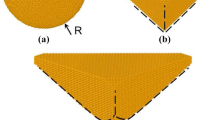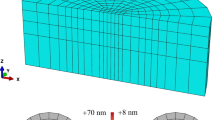Abstract
We report for the first time on load versus depth-of-indentation response of Ti3SiC2 surfaces loaded with a 13.5 μm spherical tipped diamond indenter up to loads of 500 mN. Using orientation imaging microscopy, two groups of crystals were identified; one in which the basal planes were parallel to, and the other normal to, the surface. When the load-penetration depth curves were converted to stress-strain curves the following was apparent: when the surfaces were loaded normal to the c axis, the response at the lowest loads was linear elastic—well described by a modulus of 320 GPa—followed by a clear yield point at approximately 4.5 GPa. And while the first cycle was slightly open, the next 4 on the same location were significantly harder, almost indistinguishable, and fully reversible. At the highest loads (500 mN) pop-ins due to delaminations between basal planes were observed. When pop-ins were not observed the indentations, for the most part, left no trace. When the load was applied parallel to the c axis, the initial response was again linear elastic (modulus of 320 GPa) followed by a yield point of approximately 4 GPa. Here again significant hardening was observed between the first and subsequent cycles. Each cycle resulted in some strain, but no concomitant increase in yield points. This orientation was even more damage tolerant than the orthogonal direction. This response was attributed to the formation of incipient kink bands that lead to the formation of regular kink bands. Remarkably, these dislocation-based mechanisms allow repeated loading of Ti3SiC2 without damage, while dissipating significant amounts of energy per unit volume, Wd, during each cycle. The values of Wd measured herein were in excellent agreement with corresponding measurements in simple compression tests reported earlier, confirming that the same mechanisms continue to operate even at the high (≈9 GPa) stress levels typical of the indentation experiments.
Similar content being viewed by others
Change history
01 July 2004
An Erratum to this paper has been published: https://doi.org/10.1007/BF03548933
References
M.W. Barsoum, The MN+1AXN Phass: A new class of solids: Thermodynamically stable nanolaminates, Prog. Sol. State Chem., 28, 201 (2000).
R. Pampuch, J. Lis, L. Stobierski, and M. Tymkiewicz, Solid combustion synthesis of Ti3SiC2, J. Eur. Ceram. Soc, 5, 283 (1989).
M.W. Barsoum and T. El-Raghy, Synthesis and characterization of a remarkable ceramic: Ti3SiC2, J. Am. Ceram. Soc. 79, 1953 (1996).
T. El-Raghy, M.W. Barsoum, A. Zavaliangos, and S.R. Kalidindi, Processing and mechanical properties of Ti3SiC2: II, effect of grain size and deformation temperature, J. Am. Ceram. Soc. 82, 2855 (1999).
T. El-Raghy, A. Zavaliangos, M.W. Barsoum, and S.R. Kalidindi, Damage mechanisms around hardness indentations in Ti3SiC2, J. Am. Ceram. Soc. 80, 513 (1997).
C.J. Gilbert, D.R. Bloyer, M.W. Barsoum, T. El-Raghy, A.P. Tomsia, and R.O. Ritchie, Fatigue-crack growth and fracture properties of coarse and fine-grained Ti3SiC2, Scr. Mater. 42, 761 (2000).
M. Radovic, M.W. Barsoum, T. El-Raghy, and S. Wiederhorn, Tensile creep of fine-grained (3–5 μm) Ti3SiC2 in the 1000–1200 °C temperature range, Acta Mater. 49, 4103 (2001).
I.M. Low, S.K. Lee, B. Lawn, and M.W. Barsoum, Contact damage accumulation in Ti3SiC2, J. Amer. Ceram. Soc. 81, 225 (1998).
Y. Kuroda, I.M. Low, M.W. Barsoum, and T. El-Raghy, Indentation responses and damage characteristics of hot isostatically pressed Ti3SiC2, J. Aust. Ceram. Soc. 37, 95 (2001).
M.W. Barsoum and T. El-Raghy, Room temperature ductile carbides, Met. Mater. Trans. 30 A, 363 (1999).
L. Farber, I. Levin, and M.W. Barsoum, HRTEM study of a lowangle boundary in plastically deformed Ti3SiC2, Philos. Mag. Lett. 79, 4103 (1999).
M.W. Barsoum, L. Farber, and T. El-Raghy, Dislocations, kink banks and room temperature plasticity of Ti3SiC2, Met. Mat. Trans. 30A, 1727 (1999).
M.W. Barsoum, M. Radovic, P. Finkel, and T. El-Raghy, Ti3SiC2 and ice, Appl. Phys. Lett. 79, 479 (2001).
M.W. Barsoum, T. Zhen, S. Kalidindi, M. Radovic, and A. Murugaiah, Fully reversible dislocation-based compression deformation of Ti3SiC2 to 1 GPa, Nat. Mater. 2, 107 (2003).
B.L. Adams, Orientation imaging microscopy: Emerging and future applications, Ultramicroscopy 67, 11 (1997).
D.P. Field, Recent advances in the application of orientation imaging, Ultramicroscopy 67, 1 (1997).
B.J. Kooi, R.J. Poppen, N.J.M. Carvalho, J.Th.M. De Hosson, and M.W. Barsoum, Ti3SiC2: A damage tolerant ceramic studied with nano-indentations and transmission electron microscopy, Acta. Mater. 51, 2859 (2003).
D. Tabor, Hardness of Metals (Clarendon Press, Oxford, U.K., 1951).
B.R. Lawn, N.P. Padture, H. Cai, and F. Guiberteau, Making ceramics “ductile”, Science 263, 1114 (1994).
F. Guiberteau, N.P. Padture, and B.R. Lawn, Effect of grain size on hertzian contact damage in alumina, J. Am. Ceram. Soc. 77, 1825 (1994).
J.S. Field and M.V. Swain, The indentation characterization of the mechanical properties of various carbon materials: Glassy carbon, coke, and pyrolytic Graphite, Carbon 34, 1357 (1996).
M.V. Swain and J.S. Field, Investigations of the mechanical properties of two glassy carbon materials using pointed indenters, Philos. Mag. A. 74, 1085 (1996)
M.V. Swain, Mater. Sci. Eng. Mechanical property characterization of small volumes of brittle materials with spherical tipped indenters, A253, 160 (1998).
A.C. Fischer-Cripps, A review of analysis methods for sub-micron indentation testing, Vacuum 58, 569 (2000).
N. Iwashita, M.V. Swain, J.S. Field, N. Ohta, and S. Bitoh, Elasto-plastic deformation of glass-like carbons heat-treated at different temperatures, Carbon 39, 1525 (2001).
M. Sakai, Y. Nakano, and S. Shimizu, Elastoplastic indentation on heat-treated carbons, J. Am. Ceram. Soc. 85, 1522 (2002).
B. Holm, R. Ahuja, and B. Johansson, Ab initio calculations of the mechanical properties of Ti3SiC2, Appl. Phys. Lett. 79, 1450 (2001).
M.W. Barsoum, T. El-Raghy, C.J. Rawn, W.D. Porter, A. Payzant and, C. Hubbard, Thermal properties of Ti3SiC2, J. Phys. Chem. Solids 60, 429 (1999).
F.C. Frank and A.N. Stroh, On the theory of kinking, Proc. Phys. Soc. 65, 811 (1952).
J.M. Molina-Aldareguia, J. Emmerlich, J. Palmquist, U. Jansson, and L. Hultman, Kink formation around indents in laminated Ti3SiC2 thin films studied in the nanoscale, Scri. Mater. 49, 155 (2003).
M.W. Barsoum, A. Murugaiah, S.R. Kalidindi, and Y. Gogotsi, Kink bands, nonlinear elasticity and nanoindentations in graphite, (accepted for publication).
M.W. Barsoum, A. Murugaiah, S.R. Kalidindi, and T. Zhen, Kinking nonlinear elastic solids, nanoindentations and geology, (submitted to Physical Review Letters).
S. Myhra, J.W.B. Summers and E.H. Kisi, Ti3SiC2—A layered ceramic exhibiting ultra-low friction, Mater. Let. 39, 6 (1999).
K.L. Johnson, Indentation Contact Mechanics (Cambridge University Press, Cambridge, 1985).
Author information
Authors and Affiliations
Rights and permissions
About this article
Cite this article
Murugaiah, A., Barsoum, M.W., Kalidindi, S.R. et al. Spherical Nanoindentations and Kink Bands in Ti3SiC2. Journal of Materials Research 19, 1139–1148 (2004). https://doi.org/10.1557/JMR.2004.0148
Received:
Accepted:
Published:
Issue Date:
DOI: https://doi.org/10.1557/JMR.2004.0148




